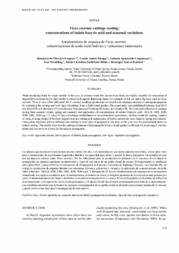Ficus enormis cuttings rooting: concentrations of indole butyric acid and seasonal variations.
Ficus enormis cuttings rooting: concentrations of indole butyric acid and seasonal variations.
Autoria: FRAGOSO, R. de O.; STUEPP, C. A.; CARPANEZZI, A. A.; WENDLING, I.; ZUFFELLATO-RIBAS, K. C.; KOEHLER, H. S.
Resumo: Plants producing fruits for many months of the year, or at times when few species bear fruits, are highly valuable for restoration of degraded ecosystems due to their ability to attract and support dispersing fauna. An example of this are native fig trees such as Ficus enormis. Thus, in view ofthe difficulties for F enormis seedlings production, we aimed at developing a method of cuttings propagation by evaluating the rooting and root vigor of cuttings from a field clonai garden. The experiment was established between June/2015 and May/2016 at Laboratory of Forest Species Propagation of Embrapa Florestas, in Colombo-PR. We evaluated collection of cuttings during three seasons (winter, spring and summer) and application of concentrations of indole-3-butyric acid - IBA (O, 1000, 2000, 3000, 4000, 5000 mg L-1). After 45 days of cuttings establishment in an acclimatized greenhouse, the best results for rooti ng , number of roots, average length of the three largest roots per cutting and maintenance of leaves and shoots were found in spring and summer. Using plant regulator did not influence the rooting or root vigor of propagules; the time of the year was the predominant factor to induce rooting. The results show that the cuttings technique with propagules from a clonai garden is efficient for producing F enormis plants and can serve as a basis for the species propagation.
Ano de publicação: 2020
Tipo de publicação: Artigo de periódico
Unidade: Embrapa Florestas
Observações
1 - Por padrão são exibidas publicações dos últimos 20 anos. Para encontrar publicações mais antigas, configure o filtro ano de publicação, colocando o ano a partir do qual você deseja encontrar publicações. O filtro está na coluna da esquerda na busca acima.
2 - Para ler algumas publicações da Embrapa (apenas as que estão em formato ePub), é necessário ter, no celular ou computador, um desses softwares gratuitos. Sistemas Android: Google Play Livros; IOS: iBooks; Windows e Linux: software Calibre.
Acesse outras publicações
Acesse a Base de Dados da Pesquisa Agropecuária (BDPA) para consultar o acervo completo das bibliotecas da Embrapa.

